QuestionQUESTION: Hi Renee, we have just lost a long horned cow fish,koran angel, volitan lion fish and oriental sweetlips to the brooklynella parasite,we think! Treated originally for white spot. We now need to know how to clean this tank so it can be reused. It is one of three that we have 200 ltrs and was being used as an emergency QT. It has an Eheim canister filter and a V2 400 skimmer. Our other stocked tank is 120 ltrs with the same filter but a smaller internal skimmer. We would like to transfer the stock from the smaller tank into the larger.The third tank was the one that housed the now deceased fish and has been left fallow. Will be used as a QT My other question is when we moved the fish into the emergency QT we also moved an atlantic anemone which is unaffected but I dont know if he will reinfect the new setup.
ANSWER: Hi Carol,
The Atlantic Anemone, also known as Condylactus, will not reinfect your aquarium.
Be certain to run all filtration with freshwater prior to introducing it back into your aquarium. The parasites can hitchhike in filtration units. Especially canisters.
To clean the tank, to reuse it, it's actually very simple.
Empty that aquarium of all fish and allow it to stand, fishless for six weeks. There will be no surviving parasites. They have to have a host to harbor their life-cycle.
If you don't want to leave it standing, wash everything with freshwater. The parasites do not live in freshwater. They do require soaking, at least 15 minutes per item, to be certain those in crevasses have died.
To cure the parasites, I just dip the sick fish in freshwater for 5 minutes, twice. It usually clears up within 48 hours.
If you choose to leave the parasite infested aquarium empty to cure it, lower salinity to 1.010 and it will speed up the death cycle. They do not fare well in low salinity.
I'm so sorry you lost your beautiful fish.
I hope I have answered all your questions. Please feel free to send in a followup if you have more questions.
Happy fish-keeping!
Renee
---------- FOLLOW-UP ----------
QUESTION: hi renee first of all thank you for the information but i do have another question i would like to ask, the 120 ltr tank i own has a regal tang,two neon damsels,one fuzzy dwarf lion fish,one foo manchu lion fish,one malui anemone,a breeding pair of common clownfish,one cleaner shrimp an one mandarin fish, now all the fish and inverts seem fine but i noticed that the regal tang and the two neon damsels seem to be showing signs of itching by scraping themselves against rocks and the regal seems to have little white spots all over its body and has lost slight coloration on its belly is there any kind of medication/treatment that is reef friendly and is effective an if so will it treat ick/whitespot and brookynella parasites as i fear i might loose all my fish and as my other two tanks are being cleansed for reuse i have no qt facilities, thank you very much carol.
ANSWER: Carol,
Those are the initial, bad, signs of Ich and yes, you do need to treat the fish.
I would dip them in freshwater. The parasites cannot survive it.
Make sure water is EXACT temperature to the water they are coming from before dipping.
Treat the water with dechlorinator. Tap water is fine to dip in.
Dip 5 minutes, twice during a 24 hour period. If it does not cure it, then dip them also, the following day.
Their hospital tank should have lower salinity than normal. 1.020 is advised.
I would heat it normally and put in ample filtration.
The fish do need treated and if it is still in their aquarium, remove them and start the process of empty tank for 6 weeks and hopefully it will right itself right away.
Do not remove your Malu Sebae Anemone, as it will perish. It has to have specific conditions. They are not hardy as the Condylactus are. It will need to remain where it is, so I advise using the 6 week no-fish clearance method for that tank while the anemone lives in it. The anemone cannot transport or contract the saltwater Ich. No worries there. Make sure to feed your malu every 3 days, as advised,while the fish are out, and to provide it with the good quality high lighting they require.
Anemone are my specialty. I would run a rescue for them, if I could.:)
There is no reef-friendly medication I recommend. There is nothing I recommend to introduce into a reef that is chemical, whatsoever, with disregard to additives and vitamins. I do not recommend any chemicals. Reef tanks are very sensitive.
If you lower salinity in the reef while it is empty, corals may perish. I suggest trapping and removing the fish using a fish trap. I have several methods of doing so. If you need advice on that, here is a great link.
http://www.youtube.com/watch?v=6P_hI7drGSQ&feature=player_embedded
I do not recommend using duct tape, but rather, use some aquarium sealant. Wait the 24 hours and allow it to seal the end of the bottle together, before using it.
Also, in addition to his video, poke small holes in the main bottle so that the smell of food will circulate throughout the tank.
For a Tang, you can make a larger version of this bottle...we caught ours easily using a large, openmouth jar turned on its side, with fishing string tied to it. When he went in to eat, I tipped it up using the fishing string and he didn't escape.
I hope this has been helpful and if you have any additional questions, please feel free to write back.
Renee
---------- FOLLOW-UP ----------
QUESTION: Renee further to my last message. I have had another look at the tang the spots are grey and raised very obvious on his black lateral line and about the size of a large grain of sand. Please help if you can.
Many thanks
Carol
AnswerThe Tang has black spot disease.
Dip him in freshwater for five minutes. It will also kill the black spot. Make 100% sure it is identical temperature to the water he is coming from.
When done with the dip, treat the hospital tank you put him in, with a formalin product. It will rid the live creatures entirely.
You may choose to remove all inverts from the main aquarium and to use the Formalin product to treat the entire tank, but I don't suggest it, because it's a reef. Try to catch and treat him separately.
Keep him moving while submersed in the freshwater. His idea will be to lay on his side, rather than to fight it.
Black spot disease is common to tangs, and is often called Tang Ich or Black Ich. Itching is a sign for both.
This is very common to Yellow Tangs.
If you need to ask further followups, Carol, please feel free. I'm so sorry about your Tang. They are such cute fish. Mine has real personality. He's like a human.
Renee

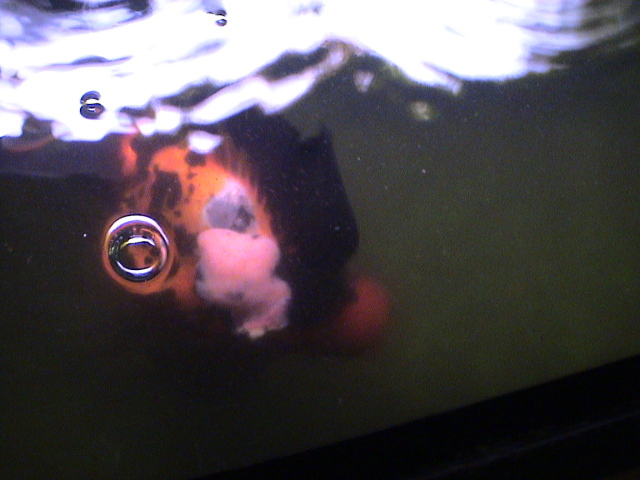 my giant goldfish
Question
my fish 012309
...my huge goldfish (once tiny)
my giant goldfish
Question
my fish 012309
...my huge goldfish (once tiny)
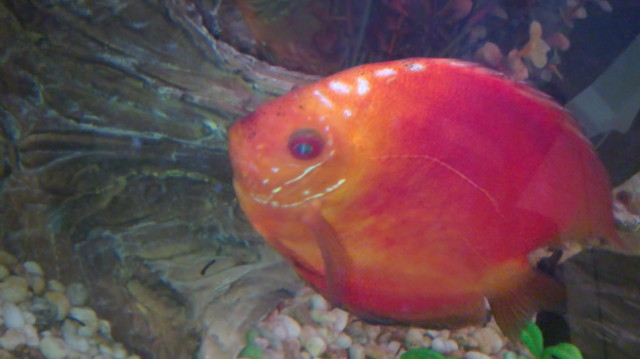 Discus fish
Question
Discus fish
Since 3 months i have been having
Discus fish
Question
Discus fish
Since 3 months i have been having
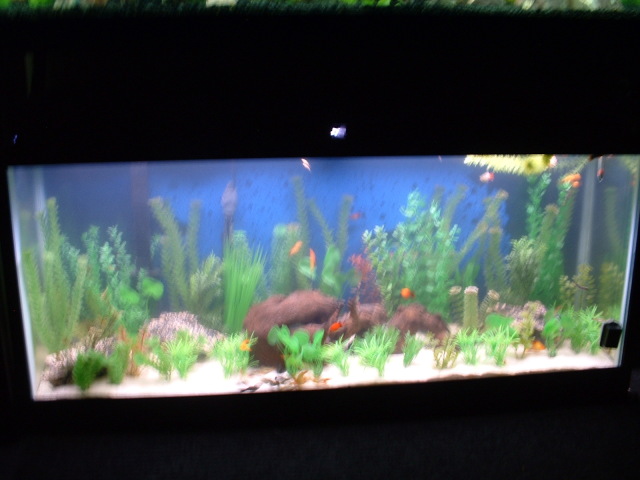 is it TB?
Question
55 galon aquarium
Hi,
I have a 55 gallon fw ta
is it TB?
Question
55 galon aquarium
Hi,
I have a 55 gallon fw ta
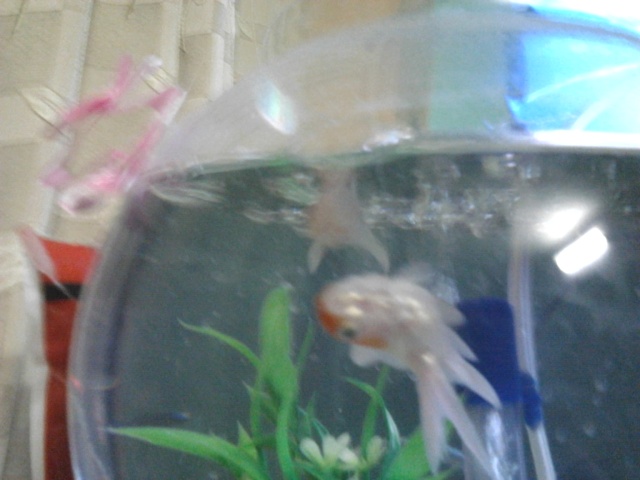 red cap oranda sick
Question
big fish (upside down)
i have 2 red cap oranda
red cap oranda sick
Question
big fish (upside down)
i have 2 red cap oranda
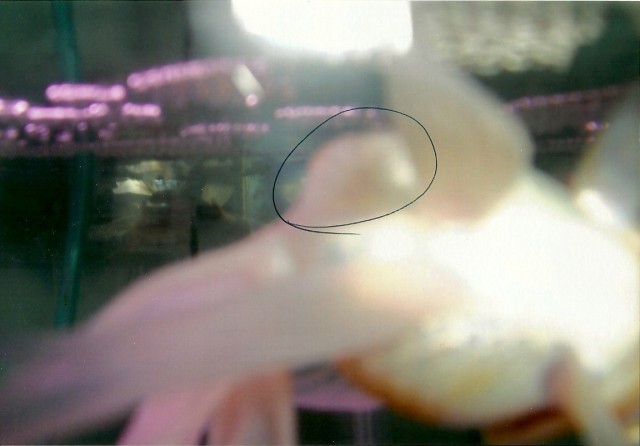 ryukin
QuestionQUESTION: I have a ryukin goldfish that has bee
ryukin
QuestionQUESTION: I have a ryukin goldfish that has bee